- Whales in Ghana
- Gazelles in Ghana
- Black-winged kite in Ghana

The wildlife of Ghana is composed of its biodiversity of fungi, flora and fauna.

The wildlife of Ghana is composed of its biodiversity of fungi, flora and fauna.
Ghana is home to a significant number of fungi species including: Aspergillus flavus ; Athelia rolfsii ; Auricularia auricula-judae ; Curvularia ; Fusarium oxysporum ; Fusarium solani f.sp. pisi; Gibberella intricans ; Gibberella stilboides ; and Macrophomina phaseolina . [1] The true total number of fungal species occurring in Ghana is in the thousands and given the generally accepted estimate that only about 7 percent of all fungi worldwide have so far been discovered and that the amount of available information is still very small. [1]
The flora of Ghana is diverse with both indigenous and introduced floral species considered in Ghana's floral diversity. [2] A total of some 3,600 species of the major regional centres of endemism represent the three major taxonomic groups. [2] Floral diversity is more pronounced among the angiosperms represented with well over 2,974 indigenous and 253 introduced species in Ghana. [3] Among the various vegetation types of the tropical rain forest, it is the wet evergreen forest type in the southwestern Ashanti-Kwahu Plain that exhibits the highest level of endemism and species richness in Ghana. [3]
Flora species diversity and endemism in the savanna biomes in Ghana is very sparse and biological diversity of species in the Ghanaian savanna woodlands and gallery forests of the savannas show greater species richness than the dry savannas. [3] Within Ghana, there are areas of high biological diversity, referred to as prime biological locations; such as the Ankasa and Nini-Suhien Conservation Area in the southwestern Ashanti-Kwahu erea terrestrial plain of Ghana, in where the climatic diversity is greater. [3] There are also Encephalartos barteri , and gymnosperm indigenous to Ghana; others growing in various Ghanaian ecological zones are introduced species for purposes including aesthetics and economic. [3] The third taxonomic group; pteridophytes, is well represented in Ghana with 124 known species. [3]


Ghana has a vast array of fauna and they are of great significance, as some of Ghana's fauna have attained conservation status because of the current rate of decline in their number and distribution. [4] The fauna of the Ghanaian terrestrial ecosystem, comprise a diverse array of species including several of conservation concern. [4] Ghanaian records show that there is as many as 221 species of amphibians and reptiles, 724 species of birds, 225 mammalian species inhabiting Ghana; with 93 recorded to be inhabiting the Ghanaian savanna ecological zone. [4] As with floral diversity, prime locations for faunal diversity is located in the Ghanaian high forest uplands; accounting for 83% of the total number of butterfly species recorded in Ghana, where canopy stratification and micro-climatic differentiation have provided habitats and niches for specific faunal organisms. [4]
Endemism among Ghanaian terrestrial fauna has been observed in three species of frogs; Hyperolius baumanni ; Hyperolius fusciventris ; and Hyperolius sylvaticus ; and the lizards; and Agama sylvanus found in the Ghanaian Bia Forest Reserve and the Atwema Range Forest Reserve. [4] Ghana has a high degree of butterfly endemism where more than 20 species are classified endemic or near-endemic. [4] Ghana is home to 84 known amphibian species: 78 frogs, 5 toads and caecilians. [4] Threatened species recorded in Ghana include four species of marine turtles and three species of crocodiles. [4] Bird species of conservation concern include seven threatened species, including four species endemic to the Upper Guinea forest block and seven near-threatened species. [4]
Keystone species such as hornbills, parrots and birds of prey (eagles) are well represented in Ghana. [4] Of the 728 birds species confirmed to be occurring in Ghana; 408 are non-passerines and 320 passerines, of which 498 are known or thought to be resident and 176 are regular seasonal bird migrants, including 100 from the Palearctic realm. [4] Of the total number of species occurring; 180 restricted to the Guinea-Congo forests biome and 37 restricted to the Sudan-Guinea savanna biome have been recorded in Ghana. [4] Eleven of the 15 endemic bird species within the Upper Guinea forest occur in Ghana. [5] Six of the total species are considered threatened and 12 are near-threatened. [5]
Ghana is an important country for dozens of vulnerable, threatened, endangered, critically endangered or near-extinct mammalian species including the primates common chimpanzee (Pan troglodytes) and western red colobus (Piliocolobus badius), the big cats lion (Panthera leo) and leopard (Panthera pardus), African bush elephant (Loxodonta africana), and water-birds, being located on the boundary of the east Atlantic Ocean Flyway and Mediterranean Flyway. There are also several rare terrestrial birds, such as the white-necked rockfowl (Picathartes gymnocephalus). [6]
This is an index of conservation topics. It is an alphabetical index of articles relating to conservation biology and conservation of the natural environment.
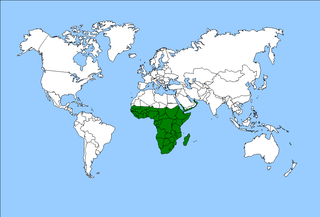
The Afrotropical realm is one of the Earth's eight biogeographic realms. It includes Sub-Saharan Africa, the southern Arabian Peninsula, the island of Madagascar, and the islands of the western Indian Ocean. It was formerly known as the Ethiopian Zone or Ethiopian Region.

The biodiversity of New Caledonia is of exceptional biological and paleoecological interest. It is frequently referred to as a biodiversity hotspot. The country is a large South Pacific archipelago with a total land area of more than 18,000 square kilometres (6,900 sq mi). The terrain includes a variety of reefs, atolls, small islands, and a variety of topographical and edaphic regions on the largest island, all of which promote the development of unusually concentrated biodiversity. The region's climate is oceanic and tropical.

The Cerrado is a vast ecoregion of tropical savanna in eastern Brazil, being present in the states of Goiás, Mato Grosso do Sul, Mato Grosso, Tocantins, Maranhão, Piauí, Bahia, Minas Gerais, São Paulo, Paraná and the Federal District. The core areas of the Cerrado biome are the Brazilian highlands – the Planalto. The main habitat types of the Cerrado consist of forest savanna, wooded savanna, park savanna and gramineous-woody savanna. The Cerrado also includes savanna wetlands and gallery forests.

The Upper Guinean forests is a tropical seasonal forest region of West Africa. The Upper Guinean forests extend from Guinea and Sierra Leone in the west through Liberia, Côte d'Ivoire and Ghana to Togo in the east, and a few hundred kilometers inland from the Atlantic coast. A few enclaves of montane forest lie further inland in the mountains of central Guinea and central Togo and Benin.

The Guinean forest-savanna, also known as the Guinean forest-savanna transition, is a distinctive ecological region located in West Africa. It stretches across several countries including Guinea, Sierra Leone, Liberia, Ivory Coast, Ghana, Togo, Benin, Nigeria, and Cameroon. This region is characterized by a unique blend of forested areas and savannas, creating a diverse and dynamic landscape.
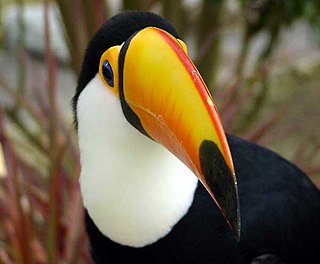
The wildlife of Brazil comprises all naturally occurring animals, plants, and fungi in the South American country. Home to 60% of the Amazon Rainforest, which accounts for approximately one-tenth of all species in the world, Brazil is considered to have the greatest biodiversity of any country on the planet. It has the most known species of plants (60,000), freshwater fish (3,000), amphibians (1,188), snakes (430), insects (90,000) and mammals (775) It also ranks third on the list of countries with the most bird species (1,971) and the third with the most reptile species (848). The number of fungal species is unknown. Approximately two-thirds of all species worldwide are found in tropical areas, often coinciding with developing countries such as Brazil. Brazil is second only to Indonesia as the country with the most endemic species.

India is one of the most biodiverse regions and is home to a large variety of wildlife. It is one of the 17 megadiverse countries and includes three of the world's 36 biodiversity hotspots – the Western Ghats, the Eastern Himalayas, and the Indo-Burma hotspot.

Burkina Faso is largely wild bush country with a mixture of grass and small trees in varying proportions. The savanna region is mainly grassland in the rainy season and semi desert during the harmattan period. Fauna, one of the most diverse in West Africa, includes the elephant, hippopotamus, buffalo, monkey, lions, crocodile, giraffe, various types of antelope, and a vast variety of bird and insect life. The country has 147 mammal species, 330 aquatic species including 121 species of fish and 2067 different plant species. Of the plant species, the dominant endemic species are shea tree and the baobab, the former plant species has immense economic value to the country.

The wildlife of Ivory Coast consists of the flora and fauna of this nation in West Africa. The country has a long Atlantic coastline on the Gulf of Guinea and a range of habitat types. Once covered in tropical rainforest, much of this habitat has been cleared, the remaining terrain being gallery forests and savanna with scattered groups of trees, resulting in a decrease in biodiversity. As of 2016, 252 species of mammal had been recorded in Ivory Coast, 666 species of bird, 153 species of reptile, 80 species of amphibian, 671 species of fish and 3660 species of vascular plant.

The wildlife of São Tomé and Príncipe is composed of its flora and fauna. São Tomé and Príncipe are oceanic islands which have always been separate from mainland West Africa and so there is a relatively low diversity of species, restricted to those that have managed to cross the sea to the islands. However the level of endemism is high with many species occurring nowhere else in the world.

The wildlife of Togo is composed of the flora and fauna of Togo, a country in West Africa. Despite its small size the country has a diversity of habitats; there are only remnants of the once more extensive rain forests in the south, there is Sudanian savanna in the north-western part of the country and larger areas of Guinean forest–savanna mosaic in the centre and north-east. The climate is tropical with distinct wet and dry seasons. There are estimated to be over 3000 species of vascular plants in the country, and 196 species of mammals and 676 species of birds have been recorded there.

The flora of Australia comprises a vast assemblage of plant species estimated to over 21,000 vascular and 14,000 non-vascular plants, 250,000 species of fungi and over 3,000 lichens. The flora has strong affinities with the flora of Gondwana, and below the family level has a highly endemic angiosperm flora whose diversity was shaped by the effects of continental drift and climate change since the Cretaceous. Prominent features of the Australian flora are adaptations to aridity and fire which include scleromorphy and serotiny. These adaptations are common in species from the large and well-known families Proteaceae (Banksia), Myrtaceae, and Fabaceae.
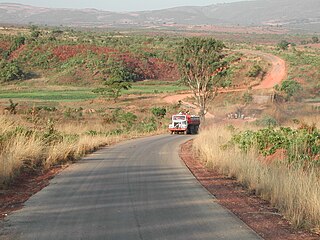
Angolan miombo woodlands cover most of central Angola and extend into the Democratic Republic of Congo. They are part of the larger miombo ecosystem that covers much of eastern and southern Africa.
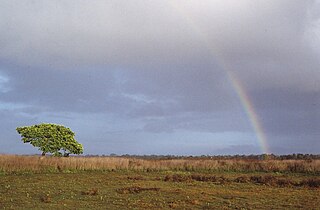
The Wasur National Park forms part of the largest wetland in Merauke Regency, South Papua, Indonesia and has been one of the least disturbed by human activity. The high value of its biodiversity has led to the park being dubbed the "Serengeti of Papua". The vast open wetland, in particular Rawa Biru Lake, attracts a very rich fauna.
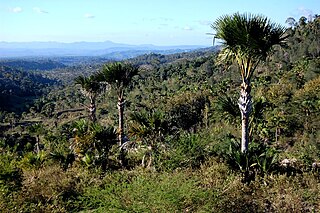
The Timor and Wetar deciduous forests is a tropical dry forest ecoregion in Indonesia and East Timor. The ecoregion includes the islands of Timor, Wetar, Rote, Savu, and adjacent smaller islands.

The Obô Natural Park of São Tomé is a natural park of São Tomé and Príncipe, covering 195 km2 (75 sq mi) of the island of São Tomé. It was established in 2006, but yet to be assigned an IUCN protected area category. It covers parts of the districts of Caué, Lemba, Lobata and Mé-Zóchi.

This is a list of topics in biodiversity.
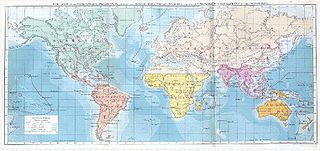
Biogeographic classification of India is the division of India according to biogeographic characteristics. Biogeography is the study of the distribution of species (biology), organisms, and ecosystems in geographic space and through geological time. India has a rich heritage of natural diversity. India ranks fourth in Asia and tenth in the world amongst the top 17 mega-diverse countries in the world. India harbours nearly 11% of the world's floral diversity comprising over 17500 documented flowering plants, 6200 endemic species, 7500 medicinal plants and 246 globally threatened species in only 2.4% of world's land area. India is also home to four biodiversity hotspots—Andaman & Nicobar Islands, Eastern Himalaya, Indo-Burma region, and the Western Ghats. Hence the importance of biogeographical study of India's natural heritage.
The Biodiversity of South Africa is the variety of living organisms within the boundaries of South Africa and its exclusive economic zone. South Africa is a region of high biodiversity in the terrestrial and marine realms. The country is ranked sixth out of the world's seventeen megadiverse countries, and is rated among the top 10 for plant species diversity and third for marine endemism.